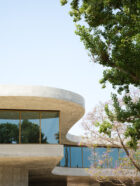City of Chicago reveals the design for the first phase of the curb-to-gate transformation of O’Hare International Airport.
Mayor Brandon Johnson and the Chicago Department of Aviation (CDA) have revealed the design for the Satellite Concourse 1 at O’Hare International Airport, the first new building in the ambitious Terminal Area Program (TAP). Designed by Skidmore, Owings & Merrill (SOM) with Ross Barney Architects, Juan Gabriel Moreno Architects (JGMA), and Arup, the bright and modern concourse will be the first new building in the largest concourse area expansion and revitalization in the airport’s 68-year history.
“On behalf of Mayor Johnson, I thank SOM, JGMA, and Ross Barney Architects for their incredible partnership over the past five years,” said Commissioner Jamie L. Rhee of the CDA. “The designs released today showcase the result of that work, and the firms’ continued commitment to meet the City’s budget expectations while still delivering a design that all of Chicago can be proud of.”
As one of the first domestic-international codeshare concourses in Chicago, Satellite Concourse 1 is designed to flexibly accommodate different aircraft bodies, increasing operational efficiency for carriers as well as layover passengers in one of the nation’s busiest airports. “We designed the new satellite concourse to create a frictionless experience for travelers, on par with the best airports in the world,” says SOM Design Partner Scott Duncan. “The gate lounges feature column-free expanses for easy wayfinding, high ceilings to improve views and air circulation, and a daylighting strategy to help align the body’s natural rhythms—all to make the experience of air travel more pleasurable.”








